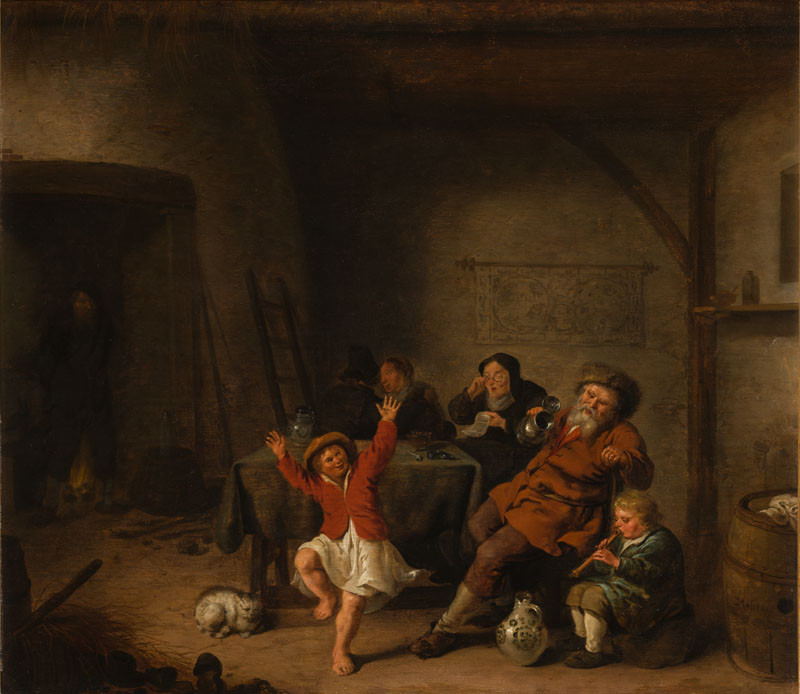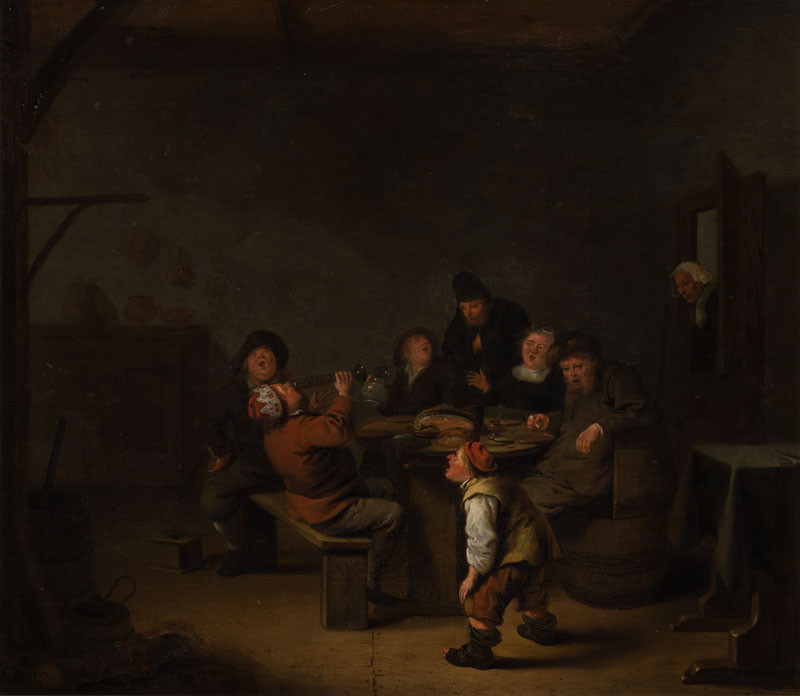The musical gathering of three generations is no mere genre scene, portraying an easy and happy family life, but a vivid illustration of the Netherlandish saying, “Soo d’ oude songem, soo pepen de jongen” (“As the old sing, so Pipe the Young”). The “piping” of the young here should be understood as an allusion to young chicks in the nest. The significance of the proverb from the point of iconography oscillates between two meanings: the Calvinist moralist Jacob Cats interprets the saying in his treatise Spiegel van den Ouden ende Nieuwen Tijd, bestaende uyt Spreeckwoorde ende Sinnspuchen (Den Haag 1632) in the sense that children inherit their character traits from their parents (Nemeth It could nonetheless also be understood in the sense rendered by the Jesuit Adriaen Poiters in his book Het Masker vande Wereld afgetrocken (Antwerpen 1646), or by Dirck Volkertsz. Coornhert in a book titled Zedekunst dat is Wellevenskunste... (Utrecht 1586): that is, that parents should provide their children with an example worthy of following, for children imitate the behavior of their parents, both good and bad. As far as we know, the subject was introduced to painting by Jacob Jordaens, who is at the same time an author of several renditions of the subject. The earliest version dates from 1638 (Koninklijk Museum voor Schoone Kunsten, Antwerp) in the engraving of Schelte Adamsz Bolswert. Later versions clearly show the inappropriate behavior of adults. Jan Steen, inspired by Jordaens, inserted a moral subtext in several of his versions of the subject: the children imitate the drinking, smoking and licentious behavior of their parents. In the picture now in Prague, which preceded Steen’s paintings, Jan Miense Molenaer revisited Jordaens’s compositions that are now in Antwerp. His old woman singing from a score, holding her spectacles, as well as a plump youth rendered in profile playing the flute was quite literally derived from him; less faithful is his version of the old man setting the tempo. In Molenaer’s picture, the old man is holding an almost empty jug of beer. In contrast to Jordaens or later Steen, Molenaer did not choose refined urbanites for his interpretation of the saying, but instead the common peasant class, which had been used since the 15th century in both literature and the fine arts to represent all types of vice. The Prague picture was very likely created after 1648, when Molenaer returned from Amsterdam to Heemsted near Haarlem, and dedicated himself more to peasant themes with a smaller number of figures, such as are exemplified by the work of Adriaen Ostade. He did not, however, follow this great master in terms of style, instead focusing on the Flemish (or also Rotterdam) rustic genre. Humble peasant dwellings with small figures are reminiscent of the peasant indoor scenes by David II Teniers. The moralizing critique present in these pictures is clearly visible in the symbolic of the musical instruments. Since Antiquity, stringed instruments were regarded as “good”, since they pacified the senses, whereas wind instruments were "bad", as they seduced one into debauchery. This is expressed in both myths of the musical contest of Apollo and the satyr Marsyas (Ovid, Metamorphoses, 382-400) and the sylvan god Pan (Ovid, Met. XI, 153-179). While Apollo played the zither, Pan played the syrinx and Marsyas played an aulos - a double flute which was discovered but abandoned by Athena, since playing the flute deformed her face by puffing her cheeks out. Philip Galle’s engraving made after Frans Floris presents a detailed comparison of both types of music. Women dressed in a decorous manner play stringed instruments, which dampen passions, while semi-naked men arouse passions with their wind instruments. It is thus no accident that in the picture As the Old Sing, So Pipe the Young, wind instruments are used. This is shown quite clearly also in the comparison with an older iconographic tradition of domestic concerts, when the members of the family play stringed instrument, engaging in disciplined joint musical session. Such family concerts were an expression of familial harmony and accord; Molenaer himself portrayed his family in a concert portrait around 1635. The painting displays all attributes of the upper class bourgeois estate - costly attire, a richly furnished room with pilasters and a drapery, valuable stringed instruments - and in terms of content it just provides an antithesis to the peasant genre of the picture As the Old Sing, So Pipe the Young. Strikingly incongruous in the context of the humble dwelling are a map of the starry firmament and constellations inscribed within large circles, as well as two smaller maps of the world on the back wall. These demonstrate the universal validity of the saying for all constellations and lands. Molenaer’s pictures also feature illustrations of the five senses: hearing, sense of smell (smoking requisites on the table), taste (beer drinker), sight (reading old woman), and feeling (the playful lovers in the background).

